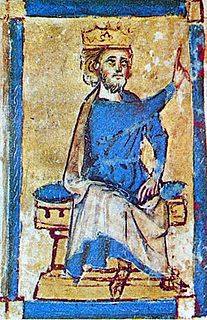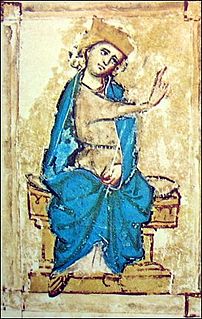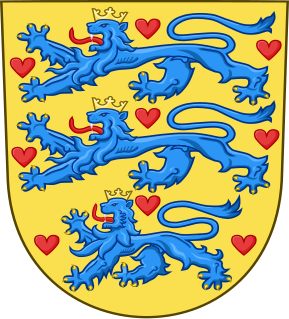Related Research Articles

Eric IV, also known as Eric Ploughpenny or Eric Plowpenny, was king of Denmark from 1241 until his death in 1250. His reign was marked by conflict and civil wars against his brothers.

Eric V Klipping was King of Denmark (1259–1286) and son of King Christopher I of Denmark. From 1259-1266, he ruled under the auspices of his competent mother, Margaret Sambiria (1230-1282). Between 1261 and 1262, the young King Eric was a prisoner in Holstein following a military defeat. Afterwards, he lived in Brandenburg, where he was initially held captive by John I, Margrave of Brandenburg.

Margaret Sambiria was Queen of Denmark by marriage to King Christopher I, and regent during the minority of her son, King Eric V from 1259 until 1264. She is the first woman confirmed to have formally ruled as regent of Denmark. She was the reigning fief-holder of Danish Estonia in 1266–1282.

Ingeborg Magnusdotter of Sweden was Queen of Denmark by marriage to King Eric VI. She was the daughter of King Magnus III of Sweden and Helwig of Holstein.

Øm Abbey was a Cistercian monastery founded in 1172 in the Diocese of Aarhus near the town of Rye, between the lakes of Mossø and Gudensø in central Jutland, Denmark. It is one of many former monasteries and abbeys in the highland region of Søhøjlandet.

St. Catherine's Priory, Roskilde, was a priory of Dominican friars located in Roskilde. It was dissolved in the Reformation and a private house built on the site.

Roskilde Abbey or Our Lady's Abbey, Roskilde was a monastery of nuns dedicated to Saint Mary the Virgin. The abbey was located at Roskilde on the Danish island of Zealand. It was founded in the early 12th century for Benedictine nuns, but in 1177 became part of the Cistercian reform movement. The abbey was suppressed in 1536 during the Protestant Reformation in Denmark. It is now the site the Old Church of Our Lady, Roskilde
Slangerup Abbey was a monastery first entrusted to the Benedictine nuns, then to the Cistercian nuns. It was in operation between 1170 and 1555 and was located in Slangerup, Denmark. There are no visible remains of the former Slangerup abbe..
St. Agnes Priory was established by Queen Margaret I for a community of Dominican nuns at Gavnø Island. After the Danish Reformation the priory was transformed into a manor estate known as Gavnø Castle located near Næstved, Denmark.

Jutta of Saxony was a Danish Queen consort, spouse of King Eric IV of Denmark. Jutta was the daughter of Albert I, Duke of Saxony. She married king Erik in 1239, and became junior queen consort, since her husband was junior king, even though there were no senior queen at the time. She would become senior queen in 1242.

Jutta of Denmark also known as Judith (1246-1286/95) was a daughter of Eric IV of Denmark and his wife Jutta of Saxony. She was a younger sister of Queen Sophia of Sweden, and Queen Ingeborg of Norway, as well as an older sister of Agnes. Jutta was also mistress for a brief period of time to her brother-in-law Valdemar, King of Sweden. Jutta was a member of the House of Estridsen.

The House of Estridsen was a dynasty that provided the kings of Denmark from 1047 to 1412. The dynasty is named after its ancestor Estrid Svendsdatter. The dynasty is sometimes called the Ulfinger, after Estrid's husband, Ulf the Earl. The dynasty also provided three of the rulers of Sweden in the years 1125–1412. Their family coat of arms became the coat of arms of Denmark and therefore influenced the coat of arms of Tallinn and the coat of arms of Estonia.
Agnes of Denmark was the youngest daughter of Eric IV of Denmark and his wife Jutta of Saxony. She was the official founder of the St. Agnes' Priory, Roskilde, becoming prioress there.
Ingerd Jakobsdatter, also called Ingerd af Regenstein (1200–1258) was a Danish noble, countess of Regenstein by marriage to count Konrad III of Regenstein. She established the Franciscan and Dominican order in Denmark, and was the founder of the female Franciscan abbey Skt. Clara Kloster af Damiani Orden.
References
- ↑ "Skt. Agnete Kloster". roskildehistorie.dk/. Retrieved August 1, 2020.
- ↑ Agnes (1249 - ca. 1290) Dansk Kvindebiografisk Leksikon
- ↑ "Jutta (ca. 1246 - 1284)". Dansk Kvindebiografisk Leksikon. Retrieved August 1, 2020.
- ↑ "Margrethe Sambiria". Dansk biografisk Lexikon. Retrieved August 1, 2020.
- ↑ "Agnes og Jutta". Roskilde Historie. Retrieved August 1, 2020.
- ↑ "Kong Erik VI Menved". Danmarks Konger. Retrieved August 1, 2020.
- ↑ "Tryggevælde". Danske Herregaarde. Retrieved August 1, 2020.